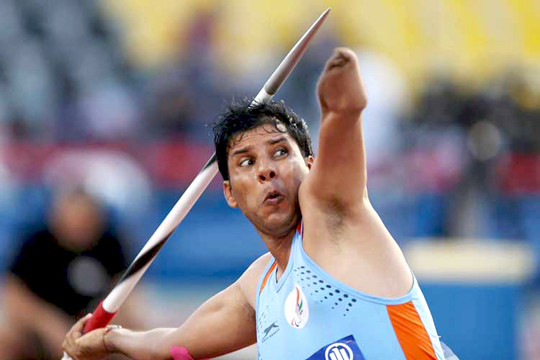New Delhi, Sep 15: India's only double gold medallist Devendra Jhajharia's grit and resilience is second to none. As an eight-year-old, the athlete's left arm had to be amputated after he got electrocuted. Having a natural flair for sports, the youngster hit the local playground as soon as he recovered from the operation. But things were no longer the same.

The man who is now the toast of the nation didn't find any kid who was interested in playing with a handicapped child. The kids made it clear that they didn't have a place for him in their team.
"You know how kids are. I had lost my arm and no one wanted to play with me. No one wanted me in their team. 'Bhaiya, hum aapko nahi khila sakte' (Sorry, we can't let you play with us), I was told on many occasions," Devendra said, recalling his childhood.
Most people would have backed out facing such a harrowing experience. But Devendra was not one of them. "It made me stronger. Every time they told me that I could not play with them, I became even more resolute," the javelin thrower said.
"After seeing that I was not going to back out, they finally included me."
Devendra won India's fourth Gold in the history of Paralympics on Tuesday with a throw of 63.97 metres in the F46 javelin event at the Olympic Stadium (Engenhao). Chunliang of China and Dinesh Priyantha Herath of Sriland bagged the silver and bronze medal respectively in the same event.
12-YEAR WAIT
The first time he bagged the yellow metal was in the 2004 Athens Paralympics with a throw of 62.15 metres.
"Things were much different back then. There was hardly any support and now with TOP scheme and Sports Authority of India's support things have changed for the better," he said.
The 2013 IPC World Athletics silver medallist had to wait 12 years for a second shot at the Olympics after his Athens Triumph as his event did not feature in the 2008 Beijing and 2012 London Games.
"It was like waiting for the Maha Kumbh (a Hindu religious gathering that takes place in India once in 12 years). I knew that my event was not there at the Beijing Paralympics, but I kept training hoping that I would get a shot at London. Only in 2010, I got to know that the event was scrapped off from London too," he said.
TRAINING IN FINLAND
Devendra went for a three month-stint to Finland under the TOP scheme this time and believes it came as huge boost to his training ahead of the Games.
"I received a lot of support this time. I also give credit to my coach Sunil Tawar. I trained for almost seven hours a day for the Games," he said.
During his stint he also met Kenyan thrower Julius Yego, who became an internet-sensation after he revealed how he learnt the art of javelin throwing solely from YouTube videos as he couldn't afford a coach. Devendra said he was mighty impressed and inspired after training with Yego. "I will definitely call him soon," said the Arjuna and Padama Shri awardee.





Comments
Add new comment